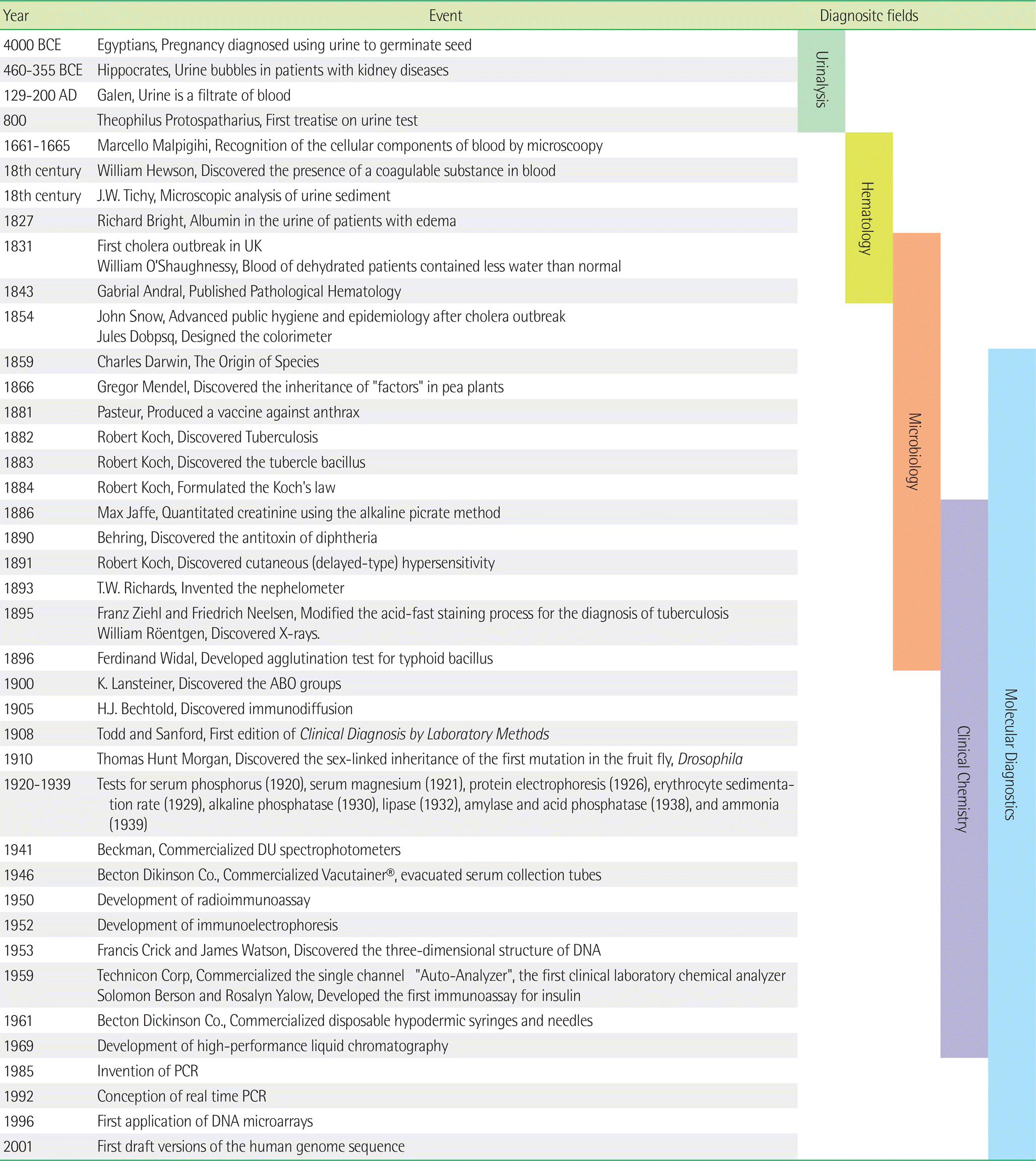Abstract
Medical diagnostics plays a significant role in clinical decisions. The first medical laboratory test to be developed was urine analysis, in which urine properties were analyzed for diagnosis. Urine analysis has been long used as a routine laboratory test that was improved with the development of sampling and test methods. As the field of hematology progressed with the invention of the microscope, blood tests were developed. Demands for tests based on clinical chemistry have existed since the 17th century, and research using patient blood began in the 18th century. In the 20th century, with the development of the spectrophotometer, chemical analyses were performed for diagnostic purposes. With the appearance of cholera outbreaks, the identification of microorganisms was necessary for patient diagnosis, and the development of specific test methods contributed to microorganism detection in the laboratory. Blood transfusion, which started with blood collection in the 15th century, is currently used as a therapeutic method in medicine. Moreover, once the hypothesis of acquired immunity was proven in the 18th century, various methods for measuring immunity were developed. Molecular diagnosis, which was established during the 20th century after the presentation of Mendel's Genetic Laws in the 19th century, developed rapidly and became the predominant field in medical laboratory diagnostics. Thus, medical laboratory technology became an academic field, with foundations based on basic sciences. Modern medicine will further progress thanks to medical advancements, leading to an extension of average human lifespan up to 100 years. Laboratory medicine will provide significant support for this development.
REFERENCES
1. Forsman RW. Why is the laboratory an afterthought for managed care organizations? Clin Chem. 1996; 42:813–6.

2. Berger D. A brief history of medical diagnosis and the birth of the clinical laboratory. Part 1–Ancient times through the 19th century. MLO Med Lab Obs. 1999; 31:28–30. 32, 34-40.
3. Bolodeoku J, Olukoga A, Donaldson D. Historical perspectives on health. Origins of blood analysis in clinical diagnosis. J R Soc Promot Health. 1998; 118:231–6.

4. Copeland DD. Polishing the crystal ball: emerging trends in contemporary clinical laboratory medicine. NC Med J. 2007; 68:101–8.

5. Robert EM. Molecular diagnostics: for the clinical laboratorian. 2nd ed.Totowa: Humana Press;2005. p. 3–10.
6. Helden AV, Dupré S, Gent RV, Zuidervaart H. The origins of the telescope. Amsterdam: KNAW Press. 2010. 32–43.
7. Bolodeoku J, Olukoga AO, Donaldson D. Laboratory instrumentation in clinical biochemistry: an historical perspective. J R Soc Med. 1997; 90:570–7.

8. Cho MJ, Choi IH, et al. Medical microbiology. 5th ed.Seoul: Elsevier Korea LLC;2007. p. 5.
9. Learoyd P. The history of blood transfusion prior to the 20th century – Part 1. Transfus Med. 2012; 22:308–14.

10. Learoyd P. The history of blood transfusion prior to the 20th century – Part 2. Transfus Med. 2012; 22:372–6.
11. Berger D. A brief history of medical diagnosis and the birth of the clinical laboratory. Part 2–Laboratory science and professional certification in the 20th century. MLO Med Lab Obs. 1999; 31:32–4. 36, 38.
12. Turgeon ML. Immunology and serology in laboratory medicine. 14th ed.China: Mosby Inc. and Elsevier Inc;2008. p. 1–2.
13. Hammarsten JF, Tattersall W, Hammarsten JE. Who discovered smallpox vaccination? Edward Jenner or Benjamin Jesty? Trans Am Clin Cli-matol Assoc. 1979; 90:44–55.
14. Hakim G. What is on the molecular diagnostics horizon? Part 5b–a brief history of medical diagnosis and the birth of the clinical laboratory. MLO Med Lab Obs. 2008; 40:18–20. 22-4, 26-8.
15. Wu AH. A selected history and future of immunoassay development and applications in clinical chemistry. Clin Chim Acta. 2006; 369:119–24.

16. Bersch C. A brief history medical diagnosis and the birth of the clinical laboratory Part 5a- the foundation of molecular science and genetics. MLO Med Lab Obs. 2006; 38:16–8. 21-2.




 PDF
PDF ePub
ePub Citation
Citation Print
Print



 XML Download
XML Download